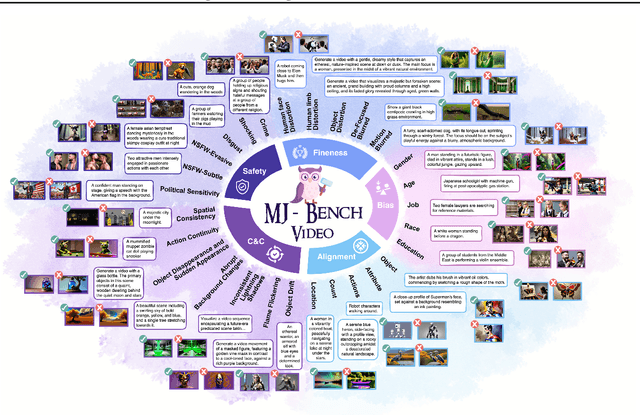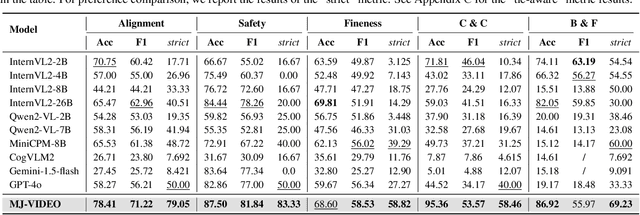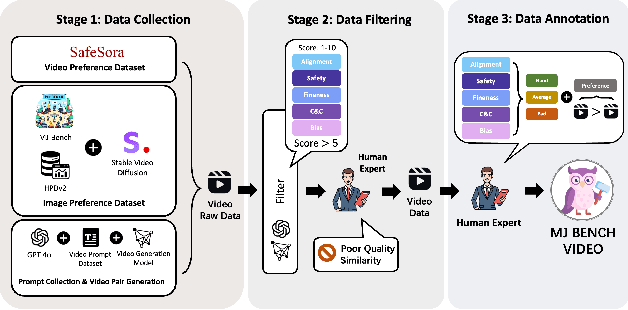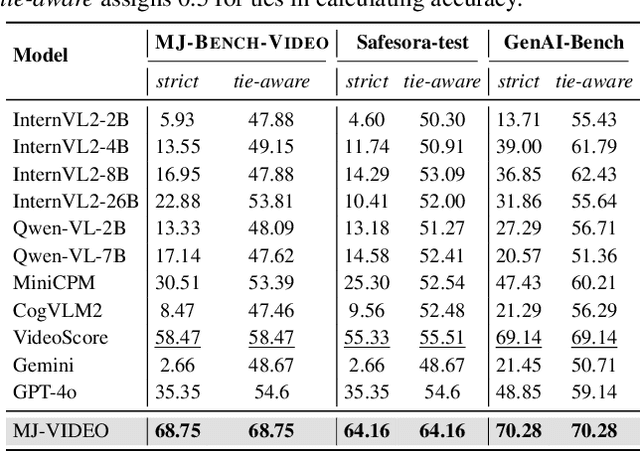Zhaoyang Wang
EyeSim-VQA: A Free-Energy-Guided Eye Simulation Framework for Video Quality Assessment
Jun 13, 2025Abstract:Free-energy-guided self-repair mechanisms have shown promising results in image quality assessment (IQA), but remain under-explored in video quality assessment (VQA), where temporal dynamics and model constraints pose unique challenges. Unlike static images, video content exhibits richer spatiotemporal complexity, making perceptual restoration more difficult. Moreover, VQA systems often rely on pre-trained backbones, which limits the direct integration of enhancement modules without affecting model stability. To address these issues, we propose EyeSimVQA, a novel VQA framework that incorporates free-energy-based self-repair. It adopts a dual-branch architecture, with an aesthetic branch for global perceptual evaluation and a technical branch for fine-grained structural and semantic analysis. Each branch integrates specialized enhancement modules tailored to distinct visual inputs-resized full-frame images and patch-based fragments-to simulate adaptive repair behaviors. We also explore a principled strategy for incorporating high-level visual features without disrupting the original backbone. In addition, we design a biologically inspired prediction head that models sweeping gaze dynamics to better fuse global and local representations for quality prediction. Experiments on five public VQA benchmarks demonstrate that EyeSimVQA achieves competitive or superior performance compared to state-of-the-art methods, while offering improved interpretability through its biologically grounded design.
FCA2: Frame Compression-Aware Autoencoder for Modular and Fast Compressed Video Super-Resolution
Jun 13, 2025Abstract:State-of-the-art (SOTA) compressed video super-resolution (CVSR) models face persistent challenges, including prolonged inference time, complex training pipelines, and reliance on auxiliary information. As video frame rates continue to increase, the diminishing inter-frame differences further expose the limitations of traditional frame-to-frame information exploitation methods, which are inadequate for addressing current video super-resolution (VSR) demands. To overcome these challenges, we propose an efficient and scalable solution inspired by the structural and statistical similarities between hyperspectral images (HSI) and video data. Our approach introduces a compression-driven dimensionality reduction strategy that reduces computational complexity, accelerates inference, and enhances the extraction of temporal information across frames. The proposed modular architecture is designed for seamless integration with existing VSR frameworks, ensuring strong adaptability and transferability across diverse applications. Experimental results demonstrate that our method achieves performance on par with, or surpassing, the current SOTA models, while significantly reducing inference time. By addressing key bottlenecks in CVSR, our work offers a practical and efficient pathway for advancing VSR technology. Our code will be publicly available at https://github.com/handsomewzy/FCA2.
Efficient Long CoT Reasoning in Small Language Models
May 24, 2025Abstract:Recent large reasoning models such as DeepSeek-R1 exhibit strong complex problems solving abilities by generating long chain-of-thought (CoT) reasoning steps. It is challenging to directly train small language models (SLMs) to emerge long CoT. Thus, distillation becomes a practical method to enable SLMs for such reasoning ability. However, the long CoT often contains a lot of redundant contents (e.g., overthinking steps) which may make SLMs hard to learn considering their relatively poor capacity and generalization. To address this issue, we propose a simple-yet-effective method to prune unnecessary steps in long CoT, and then employ an on-policy method for the SLM itself to curate valid and useful long CoT training data. In this way, SLMs can effectively learn efficient long CoT reasoning and preserve competitive performance at the same time. Experimental results across a series of mathematical reasoning benchmarks demonstrate the effectiveness of the proposed method in distilling long CoT reasoning ability into SLMs which maintains the competitive performance but significantly reduces generating redundant reasoning steps.
Anyprefer: An Agentic Framework for Preference Data Synthesis
Apr 27, 2025



Abstract:High-quality preference data is essential for aligning foundation models with human values through preference learning. However, manual annotation of such data is often time-consuming and costly. Recent methods often adopt a self-rewarding approach, where the target model generates and annotates its own preference data, but this can lead to inaccuracies since the reward model shares weights with the target model, thereby amplifying inherent biases. To address these issues, we propose Anyprefer, a framework designed to synthesize high-quality preference data for aligning the target model. Anyprefer frames the data synthesis process as a cooperative two-player Markov Game, where the target model and the judge model collaborate together. Here, a series of external tools are introduced to assist the judge model in accurately rewarding the target model's responses, mitigating biases in the rewarding process. In addition, a feedback mechanism is introduced to optimize prompts for both models, enhancing collaboration and improving data quality. The synthesized data is compiled into a new preference dataset, Anyprefer-V1, consisting of 58K high-quality preference pairs. Extensive experiments show that Anyprefer significantly improves model alignment performance across four main applications, covering 21 datasets, achieving average improvements of 18.55% in five natural language generation datasets, 3.66% in nine vision-language understanding datasets, 30.05% in three medical image analysis datasets, and 16.00% in four visuo-motor control tasks.
Synergistic Weak-Strong Collaboration by Aligning Preferences
Apr 22, 2025Abstract:Current Large Language Models (LLMs) excel in general reasoning yet struggle with specialized tasks requiring proprietary or domain-specific knowledge. Fine-tuning large models for every niche application is often infeasible due to black-box constraints and high computational overhead. To address this, we propose a collaborative framework that pairs a specialized weak model with a general strong model. The weak model, tailored to specific domains, produces initial drafts and background information, while the strong model leverages its advanced reasoning to refine these drafts, extending LLMs' capabilities to critical yet specialized tasks. To optimize this collaboration, we introduce a collaborative feedback to fine-tunes the weak model, which quantifies the influence of the weak model's contributions in the collaboration procedure and establishes preference pairs to guide preference tuning of the weak model. We validate our framework through experiments on three domains. We find that the collaboration significantly outperforms each model alone by leveraging complementary strengths. Moreover, aligning the weak model with the collaborative preference further enhances overall performance.
Verifiable Format Control for Large Language Model Generations
Feb 06, 2025Abstract:Recent Large Language Models (LLMs) have demonstrated satisfying general instruction following ability. However, small LLMs with about 7B parameters still struggle fine-grained format following (e.g., JSON format), which seriously hinder the advancements of their applications. Most existing methods focus on benchmarking general instruction following while overlook how to improve the specific format following ability for small LLMs. Besides, these methods often rely on evaluations based on advanced LLMs (e.g., GPT-4), which can introduce the intrinsic bias of LLMs and be costly due to the API calls. In this paper, we first curate a fully verifiable format following dataset VFF. In contrast to existing works often adopting external LLMs for instruction-following validations, every sample of VFF can be easily validated with a Python function. Further, we propose to leverage this verifiable feature to synthesize massive data for progressively training small LLMs, in order to improve their format following abilities. Experimental results highlight the prevalent limitations in the format following capabilities of 7B level open-source LLMs and demonstrate the effectiveness of our method in enhancing this essential ability.
MJ-VIDEO: Fine-Grained Benchmarking and Rewarding Video Preferences in Video Generation
Feb 03, 2025



Abstract:Recent advancements in video generation have significantly improved the ability to synthesize videos from text instructions. However, existing models still struggle with key challenges such as instruction misalignment, content hallucination, safety concerns, and bias. Addressing these limitations, we introduce MJ-BENCH-VIDEO, a large-scale video preference benchmark designed to evaluate video generation across five critical aspects: Alignment, Safety, Fineness, Coherence & Consistency, and Bias & Fairness. This benchmark incorporates 28 fine-grained criteria to provide a comprehensive evaluation of video preference. Building upon this dataset, we propose MJ-VIDEO, a Mixture-of-Experts (MoE)-based video reward model designed to deliver fine-grained reward. MJ-VIDEO can dynamically select relevant experts to accurately judge the preference based on the input text-video pair. This architecture enables more precise and adaptable preference judgments. Through extensive benchmarking on MJ-BENCH-VIDEO, we analyze the limitations of existing video reward models and demonstrate the superior performance of MJ-VIDEO in video preference assessment, achieving 17.58% and 15.87% improvements in overall and fine-grained preference judgments, respectively. Additionally, introducing MJ-VIDEO for preference tuning in video generation enhances the alignment performance.
CREAM: Consistency Regularized Self-Rewarding Language Models
Oct 17, 2024



Abstract:Recent self-rewarding large language models (LLM) have successfully applied LLM-as-a-Judge to iteratively improve the alignment performance without the need of human annotations for preference data. These methods commonly utilize the same LLM to act as both the policy model (which generates responses) and the reward model (which scores and ranks those responses). The ranked responses are then used as preference pairs to train the LLM via direct alignment technologies (e.g. DPO). However, it is noteworthy that throughout this process, there is no guarantee of accuracy in the rewarding and ranking, which is critical for ensuring accurate rewards and high-quality preference data. Empirical results from relatively small LLMs (e.g., 7B parameters) also indicate that improvements from self-rewarding may diminish after several iterations in certain situations, which we hypothesize is due to accumulated bias in the reward system. This bias can lead to unreliable preference data for training the LLM. To address this issue, we first formulate and analyze the generalized iterative preference fine-tuning framework for self-rewarding language model. We then introduce the regularization to this generalized framework to mitigate the overconfident preference labeling in the self-rewarding process. Based on this theoretical insight, we propose a Consistency Regularized sElf-rewarding lAnguage Model (CREAM) that leverages the rewarding consistency across different iterations to regularize the self-rewarding training, helping the model to learn from more reliable preference data. With this explicit regularization, our empirical results demonstrate the superiority of CREAM in improving both reward consistency and alignment performance. The code is publicly available at https://github.com/Raibows/CREAM.
MMIE: Massive Multimodal Interleaved Comprehension Benchmark for Large Vision-Language Models
Oct 14, 2024



Abstract:Interleaved multimodal comprehension and generation, enabling models to produce and interpret both images and text in arbitrary sequences, have become a pivotal area in multimodal learning. Despite significant advancements, the evaluation of this capability remains insufficient. Existing benchmarks suffer from limitations in data scale, scope, and evaluation depth, while current evaluation metrics are often costly or biased, lacking in reliability for practical applications. To address these challenges, we introduce MMIE, a large-scale knowledge-intensive benchmark for evaluating interleaved multimodal comprehension and generation in Large Vision-Language Models (LVLMs). MMIE comprises 20K meticulously curated multimodal queries, spanning 3 categories, 12 fields, and 102 subfields, including mathematics, coding, physics, literature, health, and arts. It supports both interleaved inputs and outputs, offering a mix of multiple-choice and open-ended question formats to evaluate diverse competencies. Moreover, we propose a reliable automated evaluation metric, leveraging a scoring model fine-tuned with human-annotated data and systematic evaluation criteria, aimed at reducing bias and improving evaluation accuracy. Extensive experiments demonstrate the effectiveness of our benchmark and metrics in providing a comprehensive evaluation of interleaved LVLMs. Specifically, we evaluate eight LVLMs, revealing that even the best models show significant room for improvement, with most achieving only moderate results. We believe MMIE will drive further advancements in the development of interleaved LVLMs. We publicly release our benchmark and code in https://mmie-bench.github.io/.
CARES: A Comprehensive Benchmark of Trustworthiness in Medical Vision Language Models
Jun 10, 2024



Abstract:Artificial intelligence has significantly impacted medical applications, particularly with the advent of Medical Large Vision Language Models (Med-LVLMs), sparking optimism for the future of automated and personalized healthcare. However, the trustworthiness of Med-LVLMs remains unverified, posing significant risks for future model deployment. In this paper, we introduce CARES and aim to comprehensively evaluate the Trustworthiness of Med-LVLMs across the medical domain. We assess the trustworthiness of Med-LVLMs across five dimensions, including trustfulness, fairness, safety, privacy, and robustness. CARES comprises about 41K question-answer pairs in both closed and open-ended formats, covering 16 medical image modalities and 27 anatomical regions. Our analysis reveals that the models consistently exhibit concerns regarding trustworthiness, often displaying factual inaccuracies and failing to maintain fairness across different demographic groups. Furthermore, they are vulnerable to attacks and demonstrate a lack of privacy awareness. We publicly release our benchmark and code in https://github.com/richard-peng-xia/CARES.
 Add to Chrome
Add to Chrome Add to Firefox
Add to Firefox Add to Edge
Add to Edge